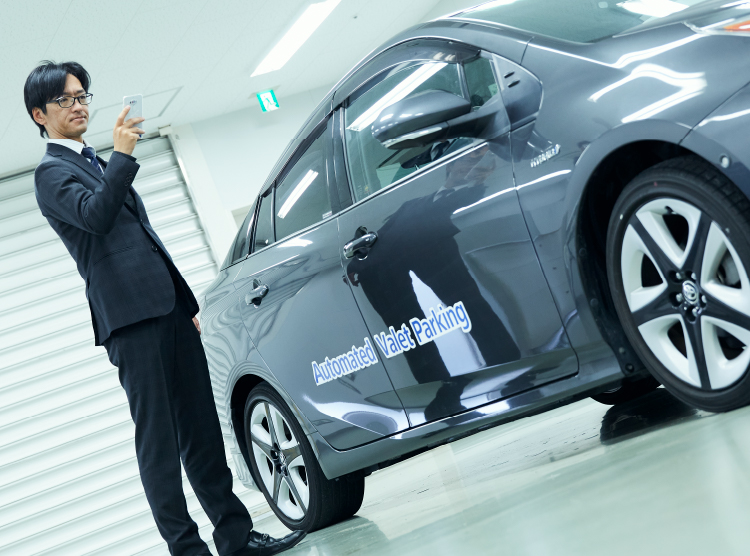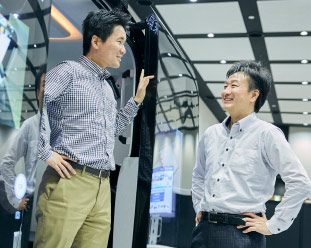

Aisin's automated valet parking projectAutomated valet parking, the ultimate form of automated parking without human intervention
Many drivers find it hard or troublesome to park a car, which requires the driver to appropriately steer to the right or left while checking the mirrors and the monitor. Also, approximately 30% of automobile-related accidents occur in parking lots.(*) Partly because of these facts, Aisin was quick to start developing automated parking technology that reduces the drivers' burden.
However, automated valet parking, which is introduced in this section, is the ultimate form of automated parking envisioned by Aisin, far beyond conventional parking support system technology. This is a technology for parking a car entirely automatically after the driver and passengers have left the car.
We interviewed Yu Tanaka, the project leader, who is advancing the development with the hope of
"Utilizing the automated parking technology not only to reduce accidents but also to realize a comfortable city to live in."
* Based on surveys conducted by the Tohoku Branch of the General Insurance Association of Japan
Index
- 1. Parking a car simply by using a smartphone generates unexpected benefits
- 2. Two problems: the harsh environment of parking lots, and difficulty of cooperation with other business operators
- 3. Aimed at generating the response: "When it comes to automated valet parking, contact Aisin."
- 4. Creating a more comfortable city to live in by popularizing the automated valet parking system

Development of Automated valet parking Yu Tanaka

 /Parking a car simply by using a smartphone generates unexpected benefits
/Parking a car simply by using a smartphone generates unexpected benefits
Reflecting its achievement as the first company in the world to introduce a system that automatically operates the steering wheel, called "Intelligent Parking Assist (IPA)" in 2003, Aisin began to develop the automated parking technology ahead of its competitors. This technology attracted attention from all quarters, and subsequently evolved into a more convenient system whereby not only the steering wheel, but also the accelerator, brakes and shift lever could be automatically operated, and was adopted in many cars.
However, the automated valet parking, which is introduced in this section, is a further advanced technology, which enables completely automated parking.
Valet parking is a parking service commonly seen in overseas countries in which after the driver leaves the key near the entrance of a hotel, etc., for a staff member to drive the car into or out of the parking lot in place of the driver.
With automated valet parking, however, all the operations that would conventionally be performed by the human intermediary are performed automatically. For example, after the driver gets out of the car at the drop-off area at the entrance to the facility and operates his/her smartphone, the car automatically drives to a parking space to finish parking. Also, at the time of retrieving the car from the parking lot, the car can be started just by operating the smartphone to come to the driver's location.
Tanaka, who leads the development team, analyzes the advantages that the automated valet parking technology brings to drivers and passengers, as described below.
"A parking lot is an accident-prone environment since vision is obstructed by pillars and walls, and pedestrians and vehicles are in close proximity to each other. If the automated valet parking technology is realized, drivers do not need to spend unnecessary time looking for a parking space, and by distinguishing between pedestrians and vehicles, it can also achieve 'ultimate safety.'
Furthermore, at facilities where the parking lot is distantly located, it also reduces the need to walk long distances."
This technology provides a great advantage not only to drivers, but also to facilities and companies that control parking lots. "Unattended parking makes it possible to decrease the distance between parking spaces, and thus 120 cars can be parked in an area that could conventionally accommodate only 100 parked cars. Facilities and companies come to make effective use of spaces that became vacant, and reduce personal costs for guidance and control in large-scale parking lots. I believe that the potential benefits of automated valet parking are huge."
Aisin started the automated valet parking project in 2015. Now it is at the stage where it has completed the demonstration experiments.
Demonstration experiments video
To use automated parking technology for community building toward transformation into compact cities
Due to the decreasing population and aging society, there is a movement toward transformation into compact cities by compacting the urban functions. To this end, it is considered necessary to reduce the area currently used for parking lots by 20 to 30%. Expanding space for humans leads to improved quality of life.
Aisin has repeatedly discussed problems related to parking lots with companies in various industries to identify several problems, including: (1) wasted space due to unused parking lots, (2) wasted time looking for vacant parking lots, and (3) personal costs for guidance and control at parking lots.
What parking method and system are required for a future vehicle society? How can we successfully lead the automated parking technology toward building a city where we can continue to live?
The automated valet parking project also embraces aspirations to solve these problems.
 Mr. Tanaka (left) and Ms. Niwa (right) talking about their thoughts for automated valet parking
Mr. Tanaka (left) and Ms. Niwa (right) talking about their thoughts for automated valet parking
 /Two problems: the harsh environment of parking lots, and difficulty of cooperation with other business operators
/Two problems: the harsh environment of parking lots, and difficulty of cooperation with other business operators
What form of automated parking will lead to building a city where everyone can continue to live comfortably? In Tanaka's project team, which includes members rearing children, development is advanced from the perspective of members in various situations and of various ages. Yukiko Niwa, who is engaged in the development of parking lot infrastructure, is one of them.
"When I let my children out of the car at a parking lot, it's very difficult to ensure their safety after they get out. However, I hadn't realized this problem until I had a child. At the same time, I also realized that elderly people and those in need of assistance faced different difficulties. So I want to use this experience in the development that I am currently engaged in."
Through repeated discussions and verifications, a blueprint of the automated valet parking development gradually took shape. However, several problems also emerged.
One of them was the unique environment of parking lots. Automated driving requires map information; however, not only can GPS signals not be received on underground floors and in multistoried parking garages, but also many parking lots have pillars, walls and other obstacles, and passageways are narrow.
Tanaka said, "If we tried to solve all the problems with technologies on the vehicle side, the car would have to be equipped with a huge number of sensors and would be very expensive. With the automated valet parking that Aisin is striving for, we use infrastructure on the parking lot side, including markers and signs, in combination, which has allowed us to achieve automated driving, bringing automated parking under the harsh conditions of parking lots closer to realization."
Guiding cars is similar to the taking off and landing of airplanes: the parking lot side serves as the airport control tower to direct the route and the allocated parking space for each car.
On the car side, image recognition, vehicle control and sensing technologies that Aisin has cultivated in the development of conventional automated parking systems have been put to full use. Low-speed, precise vehicle control, which is required for parking in a narrow space, in particular, was achieved by technologies original to Aisin.
Another problem was difficulty in cooperation with other business operators. Regarding the parking lot infrastructure, Aisin is currently developing it jointly with a parking lot equipment manufacturer. "Although we are very knowledgeable about automobile technologies, we don't know much about parking lots or information about them. So, we had to understand exactly what was required." said Niwa.
"While seeking solutions to problems by repeatedly interviewing people in different industries and actually visiting the site, we took time to create an ideal form of automated valet parking.
Since the key is to promote automated valet parking not on the vehicle side alone but in cooperation with the parking lot side, we have repeated discussions with companies in various business fields, including car sharing, delivery, shopping centers and condominiums, in addition to parking lots."
Project team members are patiently making such efforts in addition to working on the development.

 /Aimed at generating the response: "When it comes to automated valet parking, contact Aisin."
/Aimed at generating the response: "When it comes to automated valet parking, contact Aisin."
While Aisin is advancing automated valet parking development by capitalizing on its state-of-the-art technologies, various countries and manufacturers are currently engaged in intense competition. Under such circumstances, Aisin is aiming at technological development incorporating international standardization into its strategy. Tanaka said concerning its difficulty,
"Manufacturers are working on the development in competition with each other; however, if each company individually creates different technologies, they will be difficult to disseminate throughout the world. It is important to internationally standardize the mechanism of automated valet parking and promote its spread. To this end, Aisin has also taken part in the development of ISO standards. While making efforts toward international cooperation in this way, we want to roll out an automated valet parking system that is convenient and easy to introduce by making the most of Aisin's precise control technologies.
In the hope of leading the automated valet parking system that we have developed to the sustainable development of cities around the world through both competition and cooperation, we are working on daily development activities."

 /Creating a more comfortable city to live in by popularizing the automated valet parking system
/Creating a more comfortable city to live in by popularizing the automated valet parking system
Tanaka said that the most challenging part of this project in the future would be how to increase the number of introduction cases.
"Since automated valet parking will not be realized until it is connected to society, I believe the most difficult challenge is to make the world see that automated valet parking is economically viable by creating and showing model cases.
We believe that if automated valet parking is realized, not only can accidents in parking lots be reduced, but also the burden of moving in large-scale commercial facilities, airports, hospitals, condominiums and other facilities can be reduced, thereby achieving an environment more friendly to elderly people and wheelchair users."
He also said that by applying the automated valet parking system to the distribution and in-plant transportation businesses, labor shortages could be eliminated. Describing the future possibilities of automated parking, Tanaka spoke with strong conviction.
"Although we are experiencing the birthpangs, when we can meet various needs and realize that we have made an advance, we will feel truly fulfilled."
Automated parking, which had previously been like a dream, is nearing fruition. Aisin has a future plan to introduce the automated valet parking system into parking lots of facilities, etc. as its model cases.

- Automated valet parking
- A system whereby, after the driver gets out of the car in the drop-off area near the entrance to a facility and operates the smartphone, the car travels in the parking lot without human intervention to automatically complete the parking procedure








